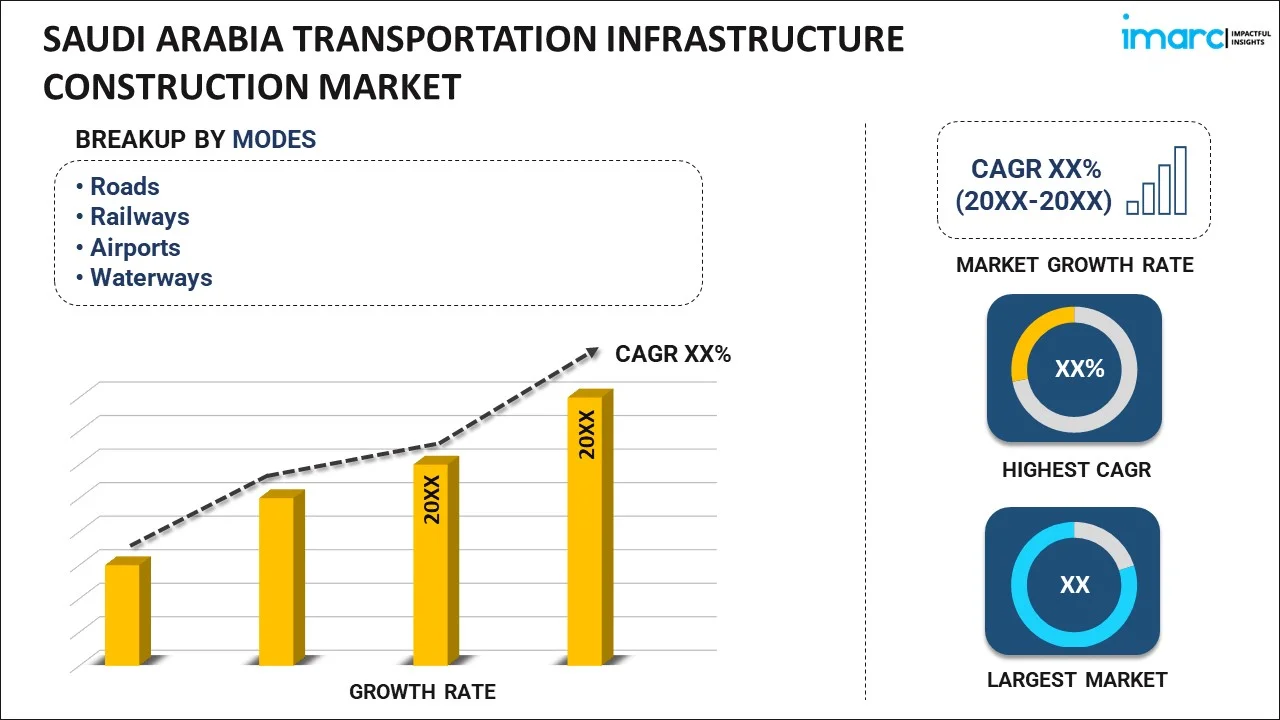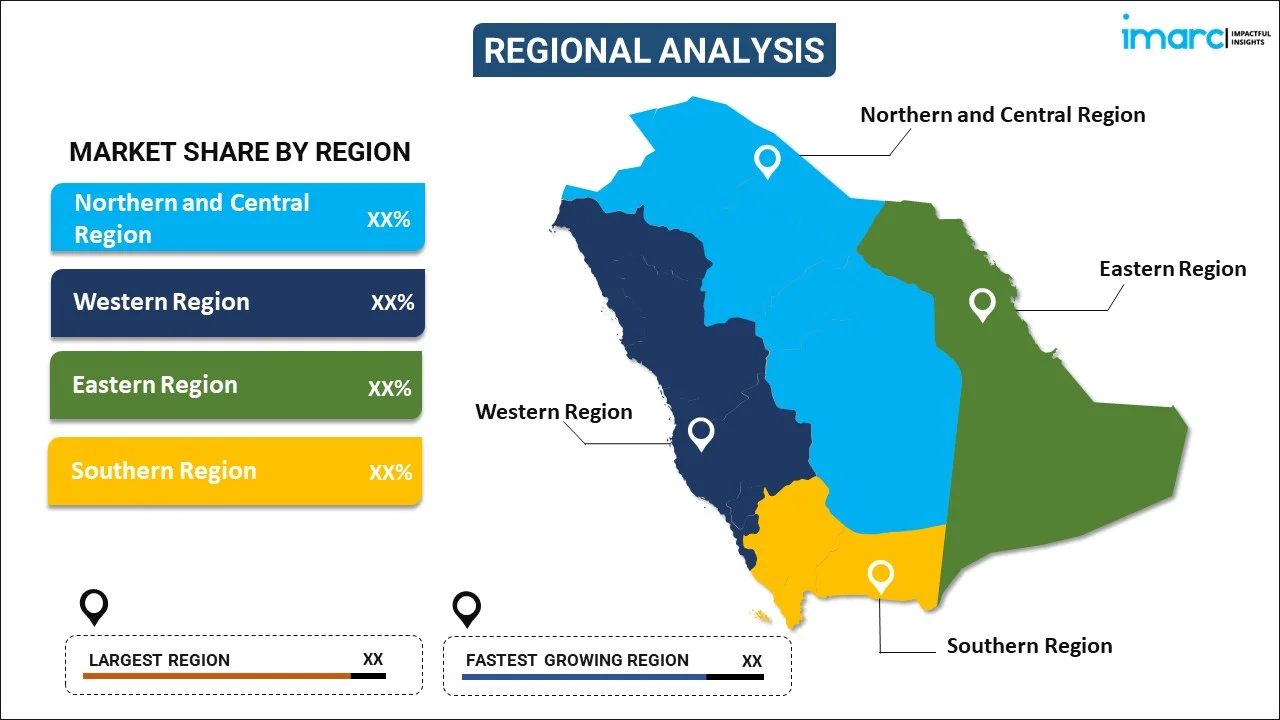
Saudi Arabia Transportation Infrastructure Construction Market Report by Mode (Roads, Railways, Airports, Waterways), and Region 2025-2033
Market Overview:
Saudi Arabia transportation infrastructure construction market size reached USD 9.9 Billion in 2024. Looking forward, IMARC Group expects the market to reach USD 12.3 Billion by 2033, exhibiting a growth rate (CAGR) of 2.20% during 2025-2033. The expansion of airports and seaports that are crucial for facilitating international trade and tourism is primarily driving the market growth.
|
Report Attribute
|
Key Statistics
|
|---|---|
|
Base Year
|
2024
|
|
Forecast Years
|
2025-2033
|
|
Historical Years
|
2019-2024
|
|
Market Size in 2024
|
USD 9.9 Billion |
|
Market Forecast in 2033
|
USD 12.3 Billion |
| Market Growth Rate 2025-2033 | 2.20% |
Transportation infrastructure construction refers to the planning, design, and construction of essential physical facilities and systems that enable the efficient movement of people, goods, and vehicles within a region or country. This construction encompasses a wide range of projects, including the building and maintenance of roads, highways, bridges, tunnels, railways, airports, ports, and public transit systems. The primary goal of transportation infrastructure construction is to create a safe, reliable, and well-connected network of transportation routes that facilitate economic growth, improve accessibility, reduce congestion, and enhance the overall quality of life for communities. These projects require careful engineering, environmental assessment, and often involve complex logistical challenges to ensure that transportation networks can support the needs of a growing population and evolving industries. Transportation infrastructure construction plays a vital role in fostering economic development, trade, and social connectivity, making it a critical component of modern society and sustainable urban development.
Saudi Arabia Transportation Infrastructure Construction Market Trends:
Growth in Tourism and Religious Pilgrimage
The thriving tourism industry is a significant driver of the market growth in Saudi Arabia. In 2024, Saudi Arabia's tourism sector reached a historic achievement, as international tourism revenue soared by 148% relative to 2019, marking the highest growth rate of all G20 countries. Millions of Muslims travel annually for Hajj and Umrah, creating immense pressure on airports, highways, and metro systems in cities like Makkah and Madinah. To improve pilgrim experiences and safety, the government is investing heavily in expanding airports, railways, and bus transit systems. Beyond pilgrimage, the Vision 2030 strategy is emphasizing tourism diversification, including luxury resorts, cultural events, and international sports, which require world-class transportation networks. Projects like the Haramain High-Speed Railway are directly serving both tourists and pilgrims, ensuring fast, reliable connectivity between holy cities.
Expansion of E-Commerce and Industrial Activities
The growth of e-commerce portals and industrial activities is catalyzing the demand for advanced transportation infrastructure in Saudi Arabia. As per the IMARC Group, the Saudi Arabia e-commerce market size reached USD 222.9 Billion in 2024. Online retail platforms and rising user expectations for fast deliveries are driving the need for efficient logistics systems, supported by strong road and warehousing connectivity. Similarly, the broadening of industrial hubs, manufacturing plants, and free economic zones requires robust transportation links to ensure smooth movement of goods across the Kingdom and to export markets. Road expansions, logistics parks, and rail freight systems are being prioritized to improve supply chain efficiency. The encouragement for smart logistics solutions is also demanding modernized transportation infrastructure that integrates digital technologies.
Adoption of Smart and Sustainable Infrastructure Solutions
Sustainability and smart infrastructure are becoming central to transportation construction in Saudi Arabia. With increasing emphasis on reducing carbon emissions, the Kingdom is adopting green building practices, energy-efficient systems, and smart mobility solutions. Projects, such as electric vehicle (EV) charging stations, eco-friendly metro systems, and smart traffic management technologies, are being integrated into new infrastructure developments. Additionally, digital solutions, such as artificial intelligence (AI)-based traffic control, intelligent toll systems, and the Internet of Things (IoT)-oriented monitoring, are modernizing Saudi Arabia’s transportation networks, ensuring they are future-ready. The adoption of sustainable and smart solutions is attracting international recognition and positioning the Kingdom as a leader in next-generation infrastructure. The Global Infrastructure Expo and Smart Cities Saudi Expo were scheduled for the Riyadh International Convention & Exhibition Center, occurring from September 15 to September 17, 2025. Concentrating on three main industry pillars, transportation, utilities, and smart technology, prominent global brands like Rashmi Metaliks were set to display innovative solutions covering urban connectivity, digital infrastructure, power plant development, and telecommunications systems.
Key Growth Drivers of Saudi Arabia Transportation Infrastructure Construction Market:
Vision 2030 and Economic Diversification Goals
Saudi Arabia’s Vision 2030 program is one of the most significant drivers of transportation infrastructure construction. The government agencies are aiming to expand the economy beyond oil and build a modern, globally connected economy, where infrastructure plays a central role. Massive investments are being made into roads, airports, railways, and seaports to improve logistics efficiency and attract international businesses. Projects like NEOM reflect this ambition, offering opportunities for both local and international construction firms. Transportation upgrades are also supporting the expansion of non-oil sectors, such as tourism, manufacturing, and retail, creating a multiplier effect on the economy. As part of Vision 2030, transportation construction is enabling Saudi Arabia to compete on a global scale and attract foreign investments.
Rising Vehicle Ownership and Road Development
Increasing number of private vehicles in Saudi Arabia is driving the need for expanded and modernized road infrastructure. With the growing incomes and population expansion, car ownership continues to increase, putting pressure on existing road networks. Highways, expressways, and urban road projects are being prioritized to reduce congestion and improve safety. Advanced traffic management systems and new road designs are being implemented to handle increasing vehicle flows efficiently. In addition, road networks play a crucial role in connecting industrial areas, cities, and rural regions, boosting both trade and tourism. Road development also complements other transport modes like metro and rail by improving last-mile connectivity. With the government’s strong focus on mobility, continuous road construction and modernization projects remain a major driver of the market growth.
Public-Private Partnerships (PPPs) and Foreign Investments
Rising PPPs and foreign investments are propelling the market growth in Saudi Arabia. Recognizing the massive capital required for infrastructure projects, the government actively collaborates with private investors and international companies to share risks and accelerate development. PPP frameworks create opportunities for global engineering and construction firms to bring expertise, innovations, and financing into large-scale projects, such as airports, toll roads, and metro systems. This approach ensures projects are completed on time and to international standards. Foreign investors are drawn to Saudi Arabia’s ambitious Vision 2030 roadmap and the nation’s strategic market potential. The inflow of capital and expertise not only speeds up construction but also promotes sustainable and technologically advanced infrastructure solutions, strengthening the overall competitiveness of Saudi Arabia’s transportation sector.
Saudi Arabia Transportation Infrastructure Construction Market Segmentation:
IMARC Group provides an analysis of the key trends in each segment of the market, along with forecasts at the country level for 2025-2033. Our report has categorized the market based on mode.
Mode Insights:

To get more information on this market, Request Sample
- Roads
- Railways
- Airports
- Waterways
The report has provided a detailed breakup and analysis of the market based on the mode. This includes roads, railways, airports, and waterways.
Regional Insights:

- Northern and Central Region
- Western Region
- Eastern Region
- Southern Region
The report has also provided a comprehensive analysis of all the major regional markets, which include Northern and Central Region, Western Region, Eastern Region, and Southern Region.
Competitive Landscape:
The market research report has also provided a comprehensive analysis of the competitive landscape in the market. Competitive analysis such as market structure, key player positioning, top winning strategies, competitive dashboard, and company evaluation quadrant has been covered in the report. Also, detailed profiles of all major companies have been provided.
Saudi Arabia Transportation Infrastructure Construction Market News:
- May 2025: Bechtel entered a partnership with the King Salman International Airport Development Company to act as the delivery partner for three new terminals at King Salman International Airport (KSIA) located in Riyadh. The new terminals would promote economic development in Riyadh and its neighboring areas, while improving global connectivity and providing a top-notch passenger experience.
- February 2025: The Royal Commission for Riyadh City (RCRC) declared the commencement of the road projects associated with the Second Group of the Riyadh Ring Roads and Main Axes Development Program. This comprised eight initiatives with a combined expenditure surpassing SR8 Billion. The initiative sought to enhance the transportation infrastructure in the capital, bettering the links between different roadways.
- January 2025: The Roads General Authority finished building a road in the Al-Ahsa governorate, utilizing recycled construction and demolition debris for the first time in the Kingdom. Incorporating recycled materials into infrastructure initiatives aided the Kingdom's aim of moving towards a circular economy.
Saudi Arabia Transportation Infrastructure Construction Market Report Coverage:
| Report Features | Details |
|---|---|
| Base Year of the Analysis | 2024 |
| Historical Period | 2019-2024 |
| Forecast Period | 2025-2033 |
| Units | Billion USD |
| Scope of the Report | Exploration of Historical Trends and Market Outlook, Industry Catalysts and Challenges, Segment-Wise Historical and Future Market Assessment:
|
| Modes Covered | Roads, Railways, Airports, Waterways |
| Regions Covered | Northern and Central Region, Western Region, Eastern Region, Southern Region |
| Customization Scope | 10% Free Customization |
| Post-Sale Analyst Support | 10-12 Weeks |
| Delivery Format | PDF and Excel through Email (We can also provide the editable version of the report in PPT/Word format on special request) |
Key Benefits for Stakeholders:
- IMARC’s industry report offers a comprehensive quantitative analysis of various market segments, historical and current market trends, market forecasts, and dynamics of the Saudi Arabia transportation infrastructure construction market from 2019-2033.
- The research report provides the latest information on the market drivers, challenges, and opportunities in the Saudi Arabia transportation infrastructure construction market.
- Porter's five forces analysis assist stakeholders in assessing the impact of new entrants, competitive rivalry, supplier power, buyer power, and the threat of substitution. It helps stakeholders to analyze the level of competition within the Saudi Arabia transportation infrastructure construction industry and its attractiveness.
- Competitive landscape allows stakeholders to understand their competitive environment and provides an insight into the current positions of key players in the market.
Key Questions Answered in This Report
The transportation infrastructure construction market in Saudi Arabia was valued at USD 9.9 Billion in 2024.
The Saudi Arabia transportation infrastructure construction market is projected to exhibit a CAGR of 2.20% during 2025-2033, reaching a value of USD 12.3 Billion by 2033.
Increasing urbanization and population growth are driving higher demand for efficient connectivity and logistics solutions, boosting large-scale infrastructure projects. The country’s strategic focus on becoming a regional trade and logistics hub is encouraging partnerships with global construction and engineering firms, accelerating development. Rising foreign direct investment (FDI) and public-private partnerships also provide financial momentum for mega-projects like NEOM and port expansions.
Need more help?
- Speak to our experienced analysts for insights on the current market scenarios.
- Include additional segments and countries to customize the report as per your requirement.
- Gain an unparalleled competitive advantage in your domain by understanding how to utilize the report and positively impacting your operations and revenue.
- For further assistance, please connect with our analysts.
 Request Customization
Request Customization
 Speak to an Analyst
Speak to an Analyst
 Request Brochure
Request Brochure
 Inquire Before Buying
Inquire Before Buying




.webp)




.webp)












